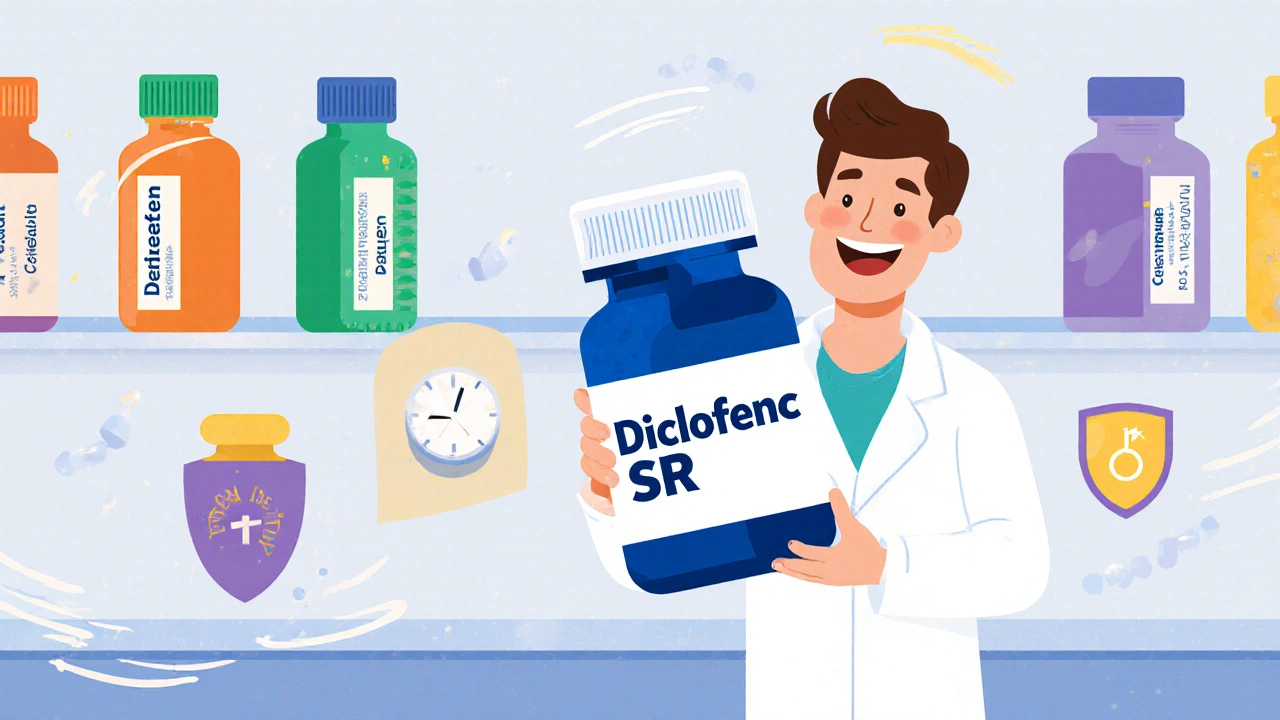NSAID Selection Tool
When you need relief from chronic joint pain, backache, or post‑surgical inflammation, the first name that pops up is often Diclofenac SR. But it’s not the only option on the shelf. Understanding how it stacks up against other non‑steroidal anti‑inflammatory drugs (NSAIDs) can prevent unwanted side effects and help you pick the right pill for your situation.
What is Diclofenac SR?
Diclofenac SR is a sustained‑release formulation of the NSAID diclofenac, designed to provide steady pain relief over 12‑24hours. It works by blocking cyclooxygenase (COX) enzymes, which reduces the production of prostaglandins-chemicals that cause pain, swelling, and fever. Because the release is gradual, patients often take it once or twice a day, which can improve adherence compared with immediate‑release tablets.
Key players in the NSAID family
To compare fairly, we need a short list of the most common alternatives:
- Ibuprofen is a short‑acting NSAID frequently used for mild to moderate pain and fever.
- Naproxen offers a longer half‑life than ibuprofen, making it popular for arthritis.
- Celecoxib is a COX‑2‑selective inhibitor marketed as a “safer” option for gastrointestinal (GI) side effects.
- Aspirin is the oldest NSAID, used mostly for low‑dose cardiovascular protection but also for pain.
How the drugs differ: a quick‑look table
| Attribute | Diclofenac SR | Ibuprofen | Naproxen | Celecoxib | Aspirin |
|---|---|---|---|---|---|
| Typical dose (adult) | 50‑150mg once or twice daily | 200‑400mg every 4‑6h (max 2400mg) | 250‑500mg twice daily | 100‑200mg once daily | 81mg low‑dose daily or 325‑650mg for pain |
| Half‑life | ~8h (sustained release up to 24h) | ~2h | ~12h | ~11h | ~3‑5h |
| COX selectivity | Non‑selective (COX‑1 & COX‑2) | Non‑selective | Non‑selective | COX‑2‑preferential | COX‑1 preferential |
| GI risk (ulcer/bleed) | Moderate‑high | Moderate | Moderate‑high | Low (but not zero) | Low at low dose, higher at analgesic dose |
| Cardiovascular risk | Elevated (especially >150mg/day) | Low‑moderate | Low‑moderate | Higher (class‑effect of COX‑2 inhibitors) | Protective at low dose, riskier at high dose |
| Common uses | Osteoarthritis, rheumatoid arthritis, post‑operative pain | Headache, dental pain, fever | Arthritis, musculoskeletal pain | Osteoarthritis, chronic back pain, where GI safety matters | Cardiovascular prophylaxis, mild pain |
When Diclofenac SR shines
Because the drug stays in the bloodstream longer, patients with steady‑state pain (like osteoarthritis) often find fewer dosing gaps. The 12‑hour dosing window can be a life‑saver for people who struggle with remembering multiple pills a day. Additionally, some studies show that diclofenac provides slightly stronger anti‑inflammatory action than ibuprofen at equivalent doses, which can mean quicker swelling reduction.

Where alternatives might be a better fit
While Diclofenac SR is effective, its non‑selective COX inhibition raises GI bleeding risk, especially in older adults or those taking anticoagulants. In those cases, a COX‑2‑selective option like Celecoxib may be safer for the stomach, though the heart‑risk profile flips upward.
People who need short‑term, occasional relief-such as a sudden migraine or a sore throat-might prefer Ibuprofen because it works quickly and is available over‑the‑counter in lower doses.
If you’re dealing with chronic inflammatory conditions but have a history of ulcers, Naproxen could be a middle ground: its longer half‑life reduces dosing frequency, yet it’s still less harsh on the gut than diclofenac when taken with a proton‑pump inhibitor.
Safety checkpoints you shouldn’t ignore
- Kidney function: All NSAIDs can impair renal perfusion, especially in dehydration or pre‑existing kidney disease. Check serum creatinine before starting long‑term therapy.
- Heart health: Diclofenac has been linked to higher rates of heart attack and stroke at doses >150mg/day. If you have hypertension or a history of cardiovascular disease, discuss alternatives with your doctor.
- GI protection: If you need an NSAID but have ulcer risk, combine the drug with a proton‑pump inhibitor (e.g., omeprazole) or choose a COX‑2‑selective agent.
- Drug interactions: Watch for interactions with anticoagulants (warfarin, DOACs), SSRIs, or other NSAIDs. Even low‑dose aspirin taken for heart protection can increase bleeding when mixed with diclofenac.
- Pregnancy: Diclofenac is generally avoided in the third trimester due to fetal circulation concerns. Ibuprofen and naproxen share similar cautions.
Practical decision tree
- If you need once‑or‑twice‑daily dosing for chronic joint pain and have no major GI or heart issues → consider Diclofenac SR.
- If you have a history of ulcers or are on blood thinners → look at Celecoxib plus a PPI, or choose Naproxen with protective meds.
- If you need quick, short‑term relief for headaches, dental work, or fever → Ibuprofen is usually sufficient.
- If low‑dose cardiovascular protection is also a goal → low‑dose Aspirin may be combined with another NSAID under doctor supervision.
Real‑world example
Mark, a 58‑year‑old carpenter, has moderate osteoarthritis in his knees. He tried over‑the‑counter ibuprofen, but the pain returned after four hours, forcing him to take another dose. His doctor prescribed Diclofenac SR 75mg twice daily, and Mark reported smoother pain control with only one night‑time dose. Six months later, routine labs showed a slight rise in creatinine, prompting a switch to naproxen with a low‑dose PPI. Mark’s case illustrates how the same condition can be managed with different NSAIDs as health parameters evolve.
Bottom line: match the drug to your profile
There’s no one‑size‑fits‑all NSAID. Diclofenac SR shines for chronic, steady pain when dosing convenience matters, but the trade‑off is higher GI and cardiovascular risk. Ibuprofen is the go‑to for occasional aches, naproxen balances longer action with moderate safety, celecoxib offers stomach protection at a heart‑risk cost, and aspirin serves dual roles in low‑dose cardio therapy.
Talk to your healthcare provider about your medical history, current meds, and lifestyle. A short conversation can steer you toward the NSAID that eases pain without opening a new health door.
Frequently Asked Questions
Can I take Diclofenac SR with a proton‑pump inhibitor?
Yes. Adding a PPI such as omeprazole can lower the risk of stomach ulcers caused by Diclofenac’s non‑selective COX inhibition. Always follow your doctor’s dosage recommendations.
Is Diclofenac SR safe for people with high blood pressure?
Diclofenac can raise blood pressure or blunt the effect of antihypertensive drugs. If you have uncontrolled hypertension, discuss alternative NSAIDs or non‑NSAID pain strategies with your physician.
How long can I stay on Diclofenac SR?
Long‑term use (beyond three months) should be monitored with periodic liver, kidney, and cardiovascular checks. Your doctor may limit duration based on your response and risk factors.
Does taking Diclofenac SR increase the risk of heart attack?
Studies show a modestly higher risk of myocardial infarction when Diclofenac is taken at doses above 150mg per day for extended periods. If you have heart disease, a COX‑2‑selective drug or a non‑NSAID analgesic may be safer.
Can I switch from Ibuprofen to Diclofenac SR without a wash‑out period?
A short overlap is usually fine, but to avoid double‑dosing, stop ibuprofen at least 4‑6hours before taking the first Diclofenac SR dose. Discuss the switch with your pharmacist if you’re uncertain.

Val Vaden
October 15, 2025 AT 12:26Looks like another pharma‑sales pitch. 🙄
lalitha vadlamani
October 26, 2025 AT 01:14While the article attempts to be comprehensive, it glosses over the ethical ramifications of promoting a drug with known cardiovascular hazards. The tone betrays a bias towards pharmaceutical convenience rather than patient safety. Moreover, the comparative table omits the recent meta‑analyses that cast doubt on the superiority of diclofenac over ibuprofen. One must therefore approach these recommendations with a skeptical eye.
kirk lapan
November 5, 2025 AT 13:02Look, the numbers in that table are fine but the real issue is the COX‑selectivity myth-people think COX‑2 selectivity automatically means a clean stomach, which is not always true. Diclofenac’s half‑life being around eight hours doesn’t magically fix the ulcer risk, especially in older adults on ACE‑inhibitors. Also, the article didn’t mention that naproxen, when taken with a PPI, can actually be gentler on the gut than diclofenac. So, before you jump on the SR hype, check your renal function and read the fine print on dosage limits.
Landmark Apostolic Church
November 16, 2025 AT 01:50Indeed, the philosophical underpinnings of pain management often get lost in the clinical jargon. One could argue that the convenience of once‑daily dosing reflects a societal shift toward instant gratification, sidelining the virtue of diligent self‑care. Yet, the balance between efficacy and safety remains a timeless ethical dilemma that each clinician must navigate.
Matthew Moss
November 26, 2025 AT 14:38Patriotic citizens deserve a medication strategy that doesn’t bow to foreign pharmaceutical conglomerates. Diclofenac, manufactured locally, offers a reliable alternative to imported ibuprofen, reducing our trade deficit while still providing effective pain relief. The cardiovascular concerns, though noted, can be mitigated through vigilant monitoring, preserving both health and national economic interests.
Antonio Estrada
December 7, 2025 AT 03:26I appreciate the detailed breakdown; it really helps people match the right NSAID to their personal health profile. Remember that lifestyle factors like diet, hydration, and regular exercise also play a big role in mitigating side effects.